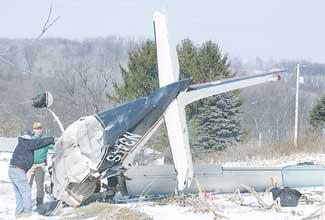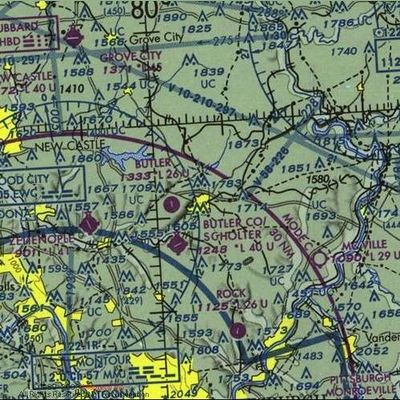No Mechanical Problems Suspected
 As ANN first reported a couple of weeks
ago (ANN, March 3, 2003:
C-182 Down In PA) Butler (PA) businessman told air
traffic controllers about a buildup of ice on the wings of his
Cessna 182. That was just moments before he impacted the
ground and was killed last month, according to a preliminary report
of the accident from the NTSB.
As ANN first reported a couple of weeks
ago (ANN, March 3, 2003:
C-182 Down In PA) Butler (PA) businessman told air
traffic controllers about a buildup of ice on the wings of his
Cessna 182. That was just moments before he impacted the
ground and was killed last month, according to a preliminary report
of the accident from the NTSB.
David Howard, 50, of Butler, was on his way home from
Philadelphia Feb. 27 when he requested to land at the Butler County
Airport. He never arrived. His C-182 was found in a field about 20
miles north of Pittsburgh the next morning.
According to the NTSB report, Howard radioed air traffic
controllers telling them he noticed ice building up on his control
surfaces.
Fragments of ice shaped like the plane's wings and tail surfaces
were found near the wreckage.
The NTSB report said Howard did not mention any mechanical
problems with the aircraft before he impacted the ground. An
initial inspection of the engine showed no problems.

NTSB Preliminary Report
NTSB Identification: NYC03FA058
14 CFR Part 91: General Aviation
Accident occurred Thursday, February 27, 2003 in Renfrew
(PA)
Aircraft: Cessna 182G, registration: N3404S
Injuries: 1 Fatal.
This is preliminary information, subject to change, and may
contain errors. Any errors in this report will be corrected when
the final report has been completed.
HISTORY OF FLIGHT
On February 27, 2003, about 2135 eastern standard time, a Cessna
182G, N3404S, was substantially damaged when it impacted terrain
near Renfrew, Pennsylvania, while executing a visual approach to
runway 8 at the Butler County Airport (BTP), Butler, Pennsylvania.
The certificated private pilot was fatally injured. Night visual
meteorological conditions prevailed for the business flight that
departed Philadelphia International Airport (PHL), Philadelphia,
Pennsylvania, destined for Butler. An instrument flight rules (IFR)
flight plan was filed and activated for the flight conducted under
14 CFR Part 91.
According to air traffic control (ATC) data, the pilot reported
accumulating a significant amount of ice while en route to Butler.
Once in the Butler area, he advised the controller he had the
airport in sight, and the controller cleared him for the visual
approach to runway 8. No report of mechanical problems was received
from the pilot before the accident. When the airplane failed to
arrive at Butler, it was listed as missing, and search and rescue
operations were initiated.
 According to a witness that was
approximately 1.2 miles northwest of the accident site, the
airplane was "very low," and descending rapidly while making a
180-degree turn. He reported that the airplane appeared to be
stable and that the landing light was on. He could not recall if he
heard any engine noise, but added that he was inside, and his
television was on. He did not witness the airplane impact the
ground.
According to a witness that was
approximately 1.2 miles northwest of the accident site, the
airplane was "very low," and descending rapidly while making a
180-degree turn. He reported that the airplane appeared to be
stable and that the landing light was on. He could not recall if he
heard any engine noise, but added that he was inside, and his
television was on. He did not witness the airplane impact the
ground.
According to another witness that was approximately 4oo feet
from the accident site, the airplane was very low, and unstable
when it flew by her bedroom window. The wings were rocking back and
forth, and she believes she heard the engine, but was not 100
percent sure. She did not witness the airplane impact the ground,
and was not aware of the accident until advised by local
authorities.
The accident occurred during the hours of darkness. The wreckage
was located at 40 degrees, 46.220 minutes north latitude, 79
degrees, 58.714 minutes west longitude, and an elevation of
approximately 1,160 feet msl.
PILOT INFORMATION
The pilot held a private pilot certificate with an airplane
single-engine-land rating, and airplane instrument rating. On his
last Federal Aviation Administration (FAA) third-class medical
certificate, dated April 23, 2002, he reported a total flight
experience of 466 hours.
METEOROLOGICAL INFORMATION
A weather observation taken at the time of the accident at the
Butler County Airport recorded the wind as 090 degrees at 5 knots,
visibility 10 miles, ceiling 3,700 feet overcast, temperature 30
degrees Fahrenheit, dew point 23 degrees Fahrenheit, and an
altimeter setting of 29.96 inches of mercury.
WRECKAGE AND IMPACT INFORMATION
The airplane impacted the ground about 1/2 mile from the
airport, and approximately 100 feet left of the extended centerline
for runway 8. Terrain in the area consisted of rolling hills,
farmland, and patches of forest. The debris path was approximately
50 feet long, orientated on a magnetic heading of 100 degrees, and
up slope approximately 5 degrees. The start of the debris path was
marked by freshly broken tree branches at the top of a 15-foot
tree. The debris path then consisted of one continues ground scar,
miscellaneous airframe components, and the main wreckage. All the
structural components of the airplane were accounted for at the
accident site. In addition, ice fragments were located at and near
the main wreckage. The fragments were approximately 2 inches thick
and 4.5 inches high. The color of the fragments was clear to
opaque, and the shapes were consistent with wing and tailplane
surfaces.
On February 28, 2003, the wreckage was moved to the Butler
County Airport, and placed in a secure hangar. On March 1, 2003,
the engine and airframe were examined.
Examination of the cockpit revealed that the airplane was not
equipped with shoulder harnesses. The seat tracks were bent and
broken, and the breaks matched the curvature of the floor. The
right seat was intact, the left seat had separated from the floor,
and the cushion along with its associated structure had separated
from the seat at all four of its connecting points. All four
fracture surfaces were gray in color and consistent with
overload.
Flight control continuity was confirmed from both ailerons to
both control yokes. Continuity of the elevator was confirmed from
the elevator to the base of the instrument panel, but not to the
control yokes because of impact damage. Rudder control continuity
was confirmed from the rudder to the forward part of the cockpit,
but not to the actual pedals because of impact damage. Elevator
trim was approximately neutral, and continuity was confirmed. The
flap switch was in the neutral position, the flap indicator showed
up, and the flaps were in the "UP" position.
The airspeed indicator displayed zero, and the vertical speed
indicator displayed 350 FPM down. The pilot altimeter indicated
7,560 feet and was set to 29.95 inches of mercury. The copilot
altimeter indicated 7,150 feet and was set to 29.95 inches of
mercury. The alternate static air was closed, and the pitot heat
was "ON." The attitude indicator displayed nose high and
approximately 45 degrees left wing low, the turn and bank indicator
displayed right wing low, and the ball was free in the race. The
No. 1 course deviation indicator (CDI) was set to 266 degrees,
showed on course, and full deflection below glideslope. The No. 2
CDI was set to 254 degrees, indicated three dots right of course,
and full deflection above glideslope. The directional gyro
indicated 231 degrees, and the magnetic compass indicated 221
degrees. The ADF needle indicated 225 degrees, and the card was set
to 035 degrees. In addition, no indication of "needle slap" was
identified on any of the flight or navigation instruments.
The ICS control panel was configured with speaker and headphone
for the No. 1 communication radio, nothing for the No. 2
communication radio, and nothing for the No. 1 navigation radio.
Speaker and headphone were selected for the No. 2 navigation radio,
and headphone was selected for the DME. Speaker and headphone were
selected for the marker beacon, and speaker was selected for the
ADF. In addition, the transmit selector was set to the No. 1
communication radio.
The No. 1 and No. 2 communication radios were "ON," and the
volumes were mid range. The No. 1 and No. 2 navigation radios were
"ON" and the volumes were approximately maximum. The ADF was "ON,"
the volume was mid range, and "ADF" was selected. The transponder
was set to 2672, and the selector switch had separated from the
unit.

The No. 1 and No. 2 communication radios, the No. 1 and No. 2
navigation radios, the Loran "C," and the ADF all had electronic
displays. The airplane battery was reinstalled, and the master
switch along with the avionics switch, were placed in the "ON"
position. All the avionics displayed indications of power, but only
the following data could be extracted. The No. 1 communication
radio was set to 124.75 MHz active and 122.8 MHz standby. The No. 2
communication radio was set to 133.82 MHz active and 122.8 MHz
standby. The No. 1 Navigation radio was set to 113.0 MHz active,
and 112.5 MHz standby.
The engine oil pressure gauge indicated zero, the engine oil
temperature gauge indicated zero, and the vacuum gauge indicated
zero. The manifold pressure gauge indicated 29 inches of mercury,
and the tachometer indicated zero RPM and 784.66 hours. The clock,
which was powered by the airplane battery indicated 2050. In
addition, no indication of "needle slap" was identified on any of
the system instruments or clock.
The fuel selector displayed impact damage, and the handle was
between "BOTH" and "OFF." The selector was opened and the valve was
in the "BOTH" position. The throttle was full forward, the mixture
was full "RICH," and the propeller control was approximately 1/2
inch aft of full forward. The carburetor heat was full forward. The
primer was in and locked. The master switch was "OFF," and magnetos
were set to "BOTH."
The propeller had separated from the engine and both blades were
attached to the propeller hub. The No. 1 blade displayed chordwise
scratches and "S" bends. The No. 2 blade was rolled back, displayed
"S" bends and chordwise scratches.
The engine case displayed minimal impact damage except for an
impact mark below the propeller flange. Continuity of the induction
and exhaust system could not be confirmed because of impact damage.
All six top sparkplugs were removed. The No. 1, 2, 4, and 6,
sparkplugs were gray in color and absent of debris. The No. 3, and
5 sparkplugs were oil soaked and absent of debris. A rotational
force was applied to the engine crankshaft, compression was
obtained on all six cylinders, valve train continuity was
confirmed, and all the top ignition leads produced spark.
Engine control continuity was confirmed from the cockpit to the
carburetor for the throttle and mixture controls, and from the
cockpit to the propeller governor for the propeller control.
Continuity of the carburetor heat control to the carburetor heat
box was confirmed, but the position of the carburetor heat valve
could not be determined because of impact damage. The throttle
valve was in the closed position. The mixture control arm had
separated from the carburetor, and the mixture control shaft was in
the full rich position.
The carburetor displayed impact damage. The fuel line from the
carburetor was removed and approximately 1.0 ounce of residual fuel
was captured. The fuel was bluish in color and absent of
contaminates. The fuel screen was removed, and absent of debris.
About 1.5 ounces of fuel was drained from the carburetor bowl. It
was bluish in color and absent of contaminates. The carburetor was
then opened, and another 0.5 ounce of fuel was drained. The fuel
was absent of debris, and had a purple tent to it. The float
assembly, needle valve, and accelerator pump were intact.
The vacuum pump was removed, the shear coupling was intact, and
the pump rotated freely. The pump was then opened. The rotor was
intact, along with all of the vanes.
The attitude indicator was removed from the instrument panel,
and the vertical gyro housing was opened. The rotor housing and
housing cover displayed a rotational scar. No rotational scarring
was identified on the rotor itself.
The carburetor ice indicator light was removed from the
instrument panel and examined. The filament was broken, displayed
no elongation, and the fracture surfaces were consistent with a
cold break.
Examination of the airplane battery revealed it was in good
condition, and capable of generating 11.17 volts. It was
reinstalled in the airplane, and no reduction in battery
performance was noted after approximately 30 minutes of having the
majority of the avionics in the "ON position and consuming
power.
ADDITIONAL INFORMATION
The wreckage was released to the owner's representative on March
1, 2003.
 ANN's Daily Aero-Linx (04.15.24)
ANN's Daily Aero-Linx (04.15.24) Classic Aero-TV: 'No Other Options' -- The Israeli Air Force's Danny Shapira
Classic Aero-TV: 'No Other Options' -- The Israeli Air Force's Danny Shapira Aero-News: Quote of the Day (04.15.24)
Aero-News: Quote of the Day (04.15.24) Airborne 04.16.24: RV Update, Affordable Flying Expo, Diamond Lil
Airborne 04.16.24: RV Update, Affordable Flying Expo, Diamond Lil ANN's Daily Aero-Term (04.16.24): Chart Supplement US
ANN's Daily Aero-Term (04.16.24): Chart Supplement US






